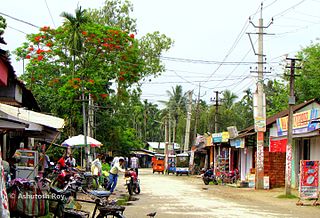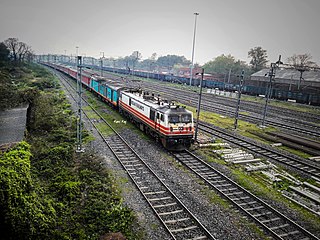
The Bodoland Territorial Region (BTR) is an autonomous division in Assam, India, and a proposed state in Northeast India. It is made up of four districts on the north bank of the Brahmaputra river below the foothills of Bhutan and Arunachal Pradesh. It is administered by an elected body known as the Bodoland Territorial Council which came into existence under the terms of a peace agreement signed in February 2003 and its autonomy was further extended by an agreement signed in January 2020. The region covers an area of over nine thousand square kilometres and is predominantly inhabited by the Bodo people and other indigenous communities of Assam.

Bongaigaon district (Prpn:ˈbɒŋgaɪˌgãʊ) is an administrative district in the state of Assam in northeastern India. The district headquarters are located at Bongaigaon. The district occupies an area of 1,093 km2.

Goalpara district is an administrative district of the Indian state of Assam.

Kokrajhar district is an administrative district in Bodoland Territorial Region of Assam. It is predominantly inhabited by the Boro tribe. The district has its headquarters located at Kokrajhar Town and occupies an area of 3,169.22 km2 (1,223.64 sq mi). It has two civil sub-divisions namely Parbatjhora and Gossaigaon and five revenue circles namely Kokrajhar, Dotma, Bhaoraguri, Gossaigaon and Bagribarilll

The Dooars or Duars are the alluvial floodplains in eastern-northeastern India and southern Bhutan that lie south of the outer foothills of the Himalayas and north of the Brahmaputra River basin. This region is about 30 km (19 mi) wide and stretches over about 350 km (220 mi) from the Teesta River in West Bengal to the Dhansiri River in Udalguri district of Assam. The region forms the gateway to Bhutan. It is part of the Terai-Duar savanna and grasslands ecoregion.

Dhubri is a town and the administrative centre of Dhubri district in the Indian state of Assam. It is an old town on the bank of the Brahmaputra river, with historical significance. In 1883, the town was first constituted as a Municipal Board under the British regime. It is situated about 277.4 kilometres (172 mi) west from Dispur, the state capital of Assam.
Kokrajhar is a town in the Bodoland Territorial Region, an autonomous territory in Assam, one of the North Eastern states of India.
Koch is a Sino-Tibetan language spoken by the Koch people of India and Bangladesh. It is primarily spoken in the Indian states of Meghalaya, West Bengal, and Lower Assam and in the parts of the country Bangladesh, where it serves as a major means of communication among the Koches and other ethnic groups in the region. Koch language is written with Assamese, Bengali, Roman scripts.

Chirang District is an administrative district in the Bodoland Territorial Region of Assam state in the North-East of India.
Basugaon (IPA:ˈbɑːsʊˌgɑ̃ʊ) is a Town in Chirang District of Assam, India. It is an industrial town and a Municipal Board area. It is a neighbourhood of Bongaigaon UA, and it is situated approximately 180 km from Guwahati City in the western part of the Lower Assam Region. The name of this town is derived from its high bamboo plantation and bamboo market basically "basu" or "bash" means bamboo and "gaon" means village that is Basugaon, 'The village of bamboo'.
Gossaigaon is one of the fastest-developing towns and the hometown of the state's youngest Raimona National Park in the Bodoland region of Assam, India. This is a sub-divisional headquarter of Kokrajhar district. It shares its boundaries with the neighboring state of West Bengal in the west and Dhubri district to the south. It is one of the BTR's proposed districts. Gossaigaon is well connected by ground transportation and rails. The town serves as a direct route by road to the state's youngest Rupsi Airport located in the southernmost part of the town. Madati and Sankosh are some of the prominent rivers that flow through the heart of the town, and forested areas include such saleable trees as Shorea robusta (sal), Tectona grandis (teak). This place practices organic farming as well as modern agriculture, following recent scientific developments.
Sapatgram is a town and a Municipality Board Area in Dhubri district in the Indian state of Assam.

The Koch are a small trans-border ethnic group of Assam and Meghalaya in India and northern Bangladesh. The group consists of nine matrilineal and strictly exogamous clans, with some of them preserving a hitherto sparsely documented Boro-Garo language called Koch, whereas others have switched to local varieties of Indo-Aryan languages. It is a Scheduled Tribe in Meghalaya, India. Koches want to preserve language and culture and heritage.

The Barauni–Guwahati railway line connects Barauni, Saharsa, Purnia and Katihar in the Indian state of Bihar and Bongaigaon, Kamakhya and Guwahati in Assam via Siliguri, Jalpaiguri, Cooch Behar and Alipurduar in West Bengal. It is a linkage of prime importance for Northeastern India with Capital of india.
Goalpara region, largely congruous to the historical undivided Goalpara district, is a region that is associated with the people and culture of Goalpara. It is bounded on the north by Bhutan, on the east by the Kamrup region, in the south by Meghalaya and in the west by Cooch Behar and Jalpaiguri in West Bengal and Rangpur in Bangladesh. The natural landmarks are: Sankosh and Brahmaputra rivers on the west, the Manas river on the east in the north bank, and a corresponding region in the south bank; the Garo Hills in the south and Bhutan Hills in the north.

Lower Assam division is one of the 5 administrative divisions of Assam in India. It was formed in 1874, consisting of the undivided Kamrup district of Western Assam, undivided Darrang and Nagaon districts of Central Assam and Khasi & Jaintia hills of Meghalaya, created for revenue purposes. The division is under the jurisdiction of a Commissioner, who is stationed at Guwahati. The division currently covers the Western Brahmaputa Valley. Shri Jayant Narlikar, IAS is the current Commissioner of Lower Assam division.

The Kamtapur Liberation Organisation is a militant organisation based in Northeast India whose objective is to unite the Kamtapur nation from West Bengal and Assam. The proposed state is to comprise all districts in West Bengal and four contiguous districts of Assam which are Cooch Behar, Darjeeling, Jalpaiguri, North and South Dinajpur and Malda, Kokrajhar, Bongaigaon, Dhubri and Goalpara, Kishanganj districts in Bihar, and Jhapa District in Nepal. The KLO was formed to address problems of the Koch Rajbongshi people such as large-scale unemployment, land alienation, perceived neglect of Kamtapuri language, identity, and grievances of economic deprivation.
Assam – 16th largest, 15th most populous and 26th most literate state of the 28 states of the democratic Republic of India. Assam is at 14th position in life expectancy and 8th in female-to-male sex ratio. Assam is the 21st most media exposed states in India. The Economy of Assam is largely agriculture based with 69% of the population engaged in it. Growth rate of Assam's income has not kept pace with that of India's during the Post-British Era; differences increased rapidly since the 1970s. While the Indian economy grew at 6 percent per annum over the period of 1981 to 2000, the same of Assam's grew only by 3.3 percent.
Deshi or Desi people are an indigenous Muslim community residing mostly in Assam and other parts of eastern India. The Deshi Muslim people can be find in Meghalaya, North Bengal, eastern Bihar, Rangpur and Bogura of Bangladesh. In West Bengal and Bihar they are known as Nashya Shaikh. Deshis are Muslim converts from Koch, Mech or other indigenous communities. In July, 2022, the Government of Assam gave them recognition as an "Indigenous Assamese Muslims" community vide an Order.












